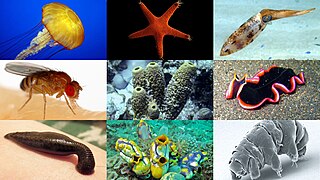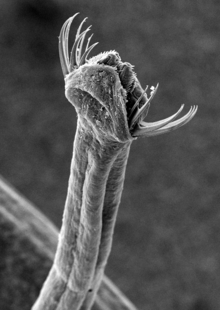
Invertebrates is an umbrella term describing animals that neither develop nor retain a vertebral column, which evolved from the notochord. It is a paraphyletic grouping including all animals excluding the chordate subphylum Vertebrata, i.e. vertebrates. Well-known phyla of invertebrates include arthropods, mollusks, annelids, echinoderms, flatworms, cnidarians and sponges.
In biology, taxonomy is the scientific study of naming, defining (circumscribing) and classifying groups of biological organisms based on shared characteristics. Organisms are grouped into taxa and these groups are given a taxonomic rank; groups of a given rank can be aggregated to form a more inclusive group of higher rank, thus creating a taxonomic hierarchy. The principal ranks in modern use are domain, kingdom, phylum, class, order, family, genus, and species. The Swedish botanist Carl Linnaeus is regarded as the founder of the current system of taxonomy, as he developed a ranked system known as Linnaean taxonomy for categorizing organisms and binomial nomenclature for naming organisms.

The Chaetognatha or chaetognaths are a phylum of predatory marine worms that are a major component of plankton worldwide. Commonly known as arrow worms, they are mostly nektonic; however about 20% of the known species are benthic, and can attach to algae and rocks. They are found in all marine waters, from surface tropical waters and shallow tide pools to the deep sea and polar regions. Most chaetognaths are transparent and are torpedo shaped, but some deep-sea species are orange. They range in size from 2 to 120 millimetres.

Thomas (Tom) Cavalier-Smith, FRS, FRSC, NERC Professorial Fellow, was a professor of evolutionary biology in the Department of Zoology, at the University of Oxford.
Eukrohniidae is a family of sagittoideans in the order Phragmophora. It consists of a single genus, Eukrohnia von Ritter-Záhony, 1909.

In biology, taxonomic rank is the relative level of a group of organisms in an ancestral or hereditary hierarchy. A common system of biological classification (taxonomy) consists of species, genus, family, order, class, phylum, kingdom, and domain. While older approaches to taxonomic classification were phenomenological, forming groups on the basis of similarities in appearance, organic structure and behaviour, methods based on genetic analysis have opened the road to cladistics.
Takasi Tokioka was a Japanese zoologist. He published over 200 scientific articles on marine animals such as chaetognaths, ctenophores, and tunicates. He was Professor of Zoology at Kyoto University working at the Seto Marine Biological Laboratory in Shirahama, Japan. From 1975 to 1977, he was the Director of SMBL.

Sagittidae is a family of sagittoideans in the order Aphragmophora.
The biological systematics and taxonomy of invertebrates as proposed by Richard C. Brusca and Gary J. Brusca in 2003 is a system of classification of invertebrates, as a way to classify animals without backbones.

Parasagitta is a genus of arrow worms in the family Sagittidae. At one time these arrow worms were classified in the genus Sagitta.
The initial version of a classification system of life by British zoologist Thomas Cavalier-Smith appeared in 1978. This initial system continued to be modified in subsequent versions that were published until he died in 2021. As with classifications of others, such as Carl Linnaeus, Ernst Haeckel, Robert Whittaker, and Carl Woese, Cavalier-Smith's classification attempts to incorporate the latest developments in taxonomy., Cavalier-Smith used his classifications to convey his opinions about the evolutionary relationships among various organisms, principally microbial. His classifications complemented his ideas communicated in scientific publications, talks, and diagrams. Different iterations might have a wider or narrow scope, include different groupings, provide greater or lesser detail, and place groups in different arrangements as his thinking changed. His classifications has been a major influence in the modern taxonomy, particularly of protists.

Phragmophora is an order of sagittoideans in the phylum Chaetognatha.
Krohnittellidae is a family of sagittoideans in the order Phragmophora. It consists of one genus, Krohnittella Germain & Joubin, 1912.
Bathybelidae is a family of sagittoideans in the order Aphragmophora. It consists of a single genus, Bathybelos Owre, 1973, which consists of a single species, Bathybelos typhlops Owre, 1973.
Krohnittidae is a family of chaetognaths in the order Aphragmophora. It consists of a single genus, Krohnitta von Ritter-Záhony, 1910.
Pterokrohniidae is a family of sagittoideans in the order Aphragmophora. I consists of a single genus, Pterokrohnia Srinivasan, 1986, which consists of a single species, Pterokrohnia arabica Srinavasan, 1986.
Pterosagittidae is a family of sagittoideans in the order Aphragmophora. It consists of a single genus, Pterosagitta Costa, 1869, which consists of a single species, Pterosagitta draco.
Spadellidae is a family of sagittoideans in the order Phragmophora. Spadellidae prey on plankton and commonly reside in the epipelagic zone of the ocean.
Caecosagitta macrocephala is a deep sea marine chaetognath that is distributed in meso- and bathypelagic layers. It has a very wide distribution that ranges from the Subantarctic to Subarctic Ocean. Cecosagitta macrocephalas have large heads, hence their name “macro-cephala”. Within their eyes are photoreceptive regions that allow them to catch weak light at bathypelagic depths. Along with their eyes, their gut or intestine has orange pigmentation and a luminous organ that gleams due to bioluminescence unlike some other species of Sagittidae. To be more precise, the luminescent organ is located on the ventral edge of each anterior lateral fin. It is the only member of the genus Caecosagitta, and only one of the two known species of bioluminescent chaetognath, the other being the distantly related Eukrohnia fowleri. C. macrocephala has a secreted bioluminescence that is thought to be coelenterazine based. The luciferase is highly unstable, being unable to survive a single freeze-thaw, and is rapidly inactivated at ice-cold temperatures.
Paraspadella is a genus of chaetognaths in the family Spadellidae. Paraspadella was originally considered as Spadella before a revision separated that genus into three genera: Spadella, Paraspadella, and Gephyrospadella, the last of which is now synonymised to Paraspadella. The initial division was based on previous knowledge of three groups of Spadella, in a similar manner in which Sagitta was divided into a family of genera. Paraspadella is differentiated from Spadella by the presence of disparate (digital) adhesive organs, present in the former to various degrees, but entirely absent in the latter.






